My hand mountable punch trackers from Hykso arrived last week. I can’t quite remember when and where I pre-ordered them but I have been looking forward to trying them out. They are designed for boxers and so geared around punching but I figured that they would be able to respond to our Choi Kwang Do techniques, which include punching of course.

The two sensors, one lights up red one lights up blue need to be strapped to the back of the hand just behind the wrist. I bought some hand wraps but they are a lot of faffing around and I found that my gel hand protectors with the larger wrist wrap hold the sensors nicely. The only problem is that I like to wear my fitbit for hear rate data, and that sits just behind the wrist too. So i placed the left one a bit closer up along the hand.
Pairing on IoS was straight forward, wakes them up with a tap and then assign to a hand.
I tested them just after a class so I was warmed up but in my own dojang. I dived right into a 2 minute PACE drill punching Bob and the bag, to realise I had actually set a 2 minute until we start recording delay. Some techie I am !
So after being even more warmed up I tried again, this with another 2 minute mix of punches, palms and knife hands. It certainly counted all the punches, something that is very hard to do at speed. That in itself is a useful extra training aid especially in the punch for 2 mins, count then, now punch for 1 min and try and get more than 50% of the last count, repeat for 30 seconds and a 15 second blast.
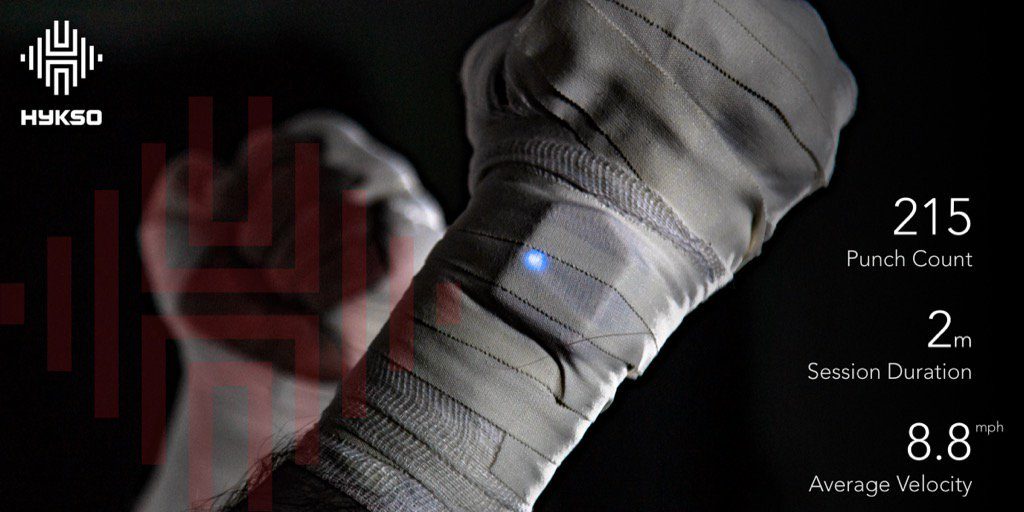
It can be distracting to get lost in numbers, but equally it provides relative indications. The app generates these images for social media, but internally shows a lot more detail, a speed, counter and “effort” monitor breaks down punches and power punches, which I think are anything not an inwards punch in Choi.
What I did notice in the graphs were my “intensity” score dropped mid session but thats when the speed rocketed up. As we often point out in training the more relaxed you are the more velocity you can punch with. A counter intuitive but effective way to focus on effort without effort.
Next I tried just the deceptively powerful reverse known hand for a few seconds. This number may be because it is confused as the hand angle on contact compared to a round punch but to go from 8mph average to 27mph strikes is very telling.
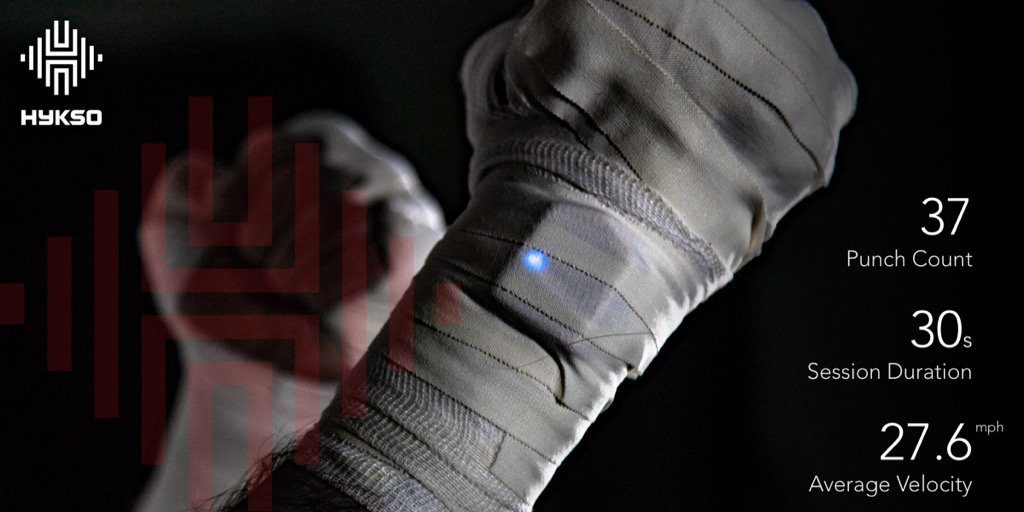
I have seen this on other equipment watching a 3rd dan get triple what most of use could register on an instrumented shield with a reverse knife hand. So for pure contact it is very effective. I suspect elbows, one of my favourite to drive a shield holder back would be along those lines but they are unlikely to register as an impact on the accelerometers in the device. I am not complaining as these are boxers tool not martial arts tools.
If the data is tracking movement and streaming it it would be really interesting to be able to profile moves such as a block and still count them. That would need an open Api or some data export but I look forward to giving it a go.
It fits with the other work I had done exploring using the Kinect
Once I get these darn wisdom teeth all extracted and sorted I can get back to proper training heading to EE Dan (2nd) and these will definitely be a tool in my conditioning arsenal. Lookout Bob!
Uncategorized
Sega – Outrun – Spotify
Those of you of a certain age, maybe not quite as old as me but close, will have really enjoyed played Sega Outrun in the arcades back in the day. Possibly in full car mock up. This tune Magical Sound Shower is a classic from then and I can see the pixelated Ferrari drifting across the track and through all the zones just listing to it. All not on spotify, well done Sega for publishing it!
Also this ! love Nights
And Space Harrier 🙂
Jet Set Radio – Oh no this is becoming a playlist 🙂
Reconfigure nomination for Sci-Fi book of the year
Whilst on our summer holiday in glorious California I got an email from the Independent Author Network book of the year awards. It said that Reconfigure was nominated as sci-fi book of the year. This is of course excellent news. I am not sure if I can fit the badge on the front cover, as some of the Amazon rules seem to say you can’t from what I remember.
Anyway here it is. I will add it to the book’s page too

It is still just 99p and sales seem to have picked up recently too. So hopefully people will enjoy it and then come and discover Cont3xt too.
With more reader there is more potential for more reviews, and that all keeps the ball rolling.
My page over at #ian1 will need updating too 🙂
Bloxels – Physical game creation tool
Before the advent of the high end PC and Mac with all the wonderful graphics tools anyone doing any game like programming would be more than accustomed to used some pencil and paper tools to build their graphics. Small square lined paper was the main tool there. Shading in individual little pieces for 16×16 sprite. Usually then converting the rows into the binary, then hexadecimal values that would drop into the data structure to the make the on screen character. Pixel art is still a big thing though and a genre in its own right.
It was interesting to see the emergence of this game making/editing toolkit that abstracts that graph paper a little, not dealing so much with pixels but with larger block and constructs in a game environment. Family Gamer TV posted this video showing it in action.
It is the physical nature of the building and configuration that makes this different to the regular point and click builds, though it can be used for that too. Having a large number of plastic blocks in different colours means kids, or adults for that matter, can gather around the “graph paper” and chop and change their design on the table top. It is not totally clear how you go back to your source code though. Generally building something you have the base components always there. Here you will clear the rack and start again on the next one. Now if it could 3d print you the “source” if you wanted to start editing from a point in someone else’s rig that would be truly awesome.
It seems that Bloxels are doing something right as they can now only ship in the US due to a lack of inventory. I think it might make an interesting change and tool in primary schools though it suggests ages 8+ I know kids younger than that would get the concept pretty quickly.
One thing with graph paper, back in the day, if you knocked it on the floor you still had your design!
Technology, under the veneer
I tend to do the family food shopping, being based at home it is good to get out and head to the supermarket, rather than online deliveries. I usually head to Sainsburys because the local store has self scan as you go around. The handset lets you scan the items as you pack them in the bags in the trolley. You then just pay by handing the scanner over (apart from occasionally getting a full rescan by the till operator to check you are being honest), and pay. A benefit of this is that you entire shop is listed on the screen and the price of the item. It is building the list as you go along and giving an indication of the amount you are spending. As the device is so small it does not contain the entire product range/barcode and price references so it is connected to a local network. Interestingly, though, it does not process the multi-buys and offers until it is handed to the cashier. I think this may be partly a systems decision and partly beneficial as the bill is always less than your handset shows.The network connection becomes apparent when something goes wrong with it. Occasionally you scan an item and the device hangs for a little while. Very occasionally, as happened yesterday it hangs completely and looks like it is not coming back. As I was at the end of my shopping trip and heading to the till, I thought I would wait rather than just hurtling off to customer services. The device shutdown and rebooted. I thought at that point I would loose everything from my 45 minute self scanning and have to do the old fashioned way of taking everything out of the trolley and put it on the conveyor belt again. The screen sparked back into life and this happened.
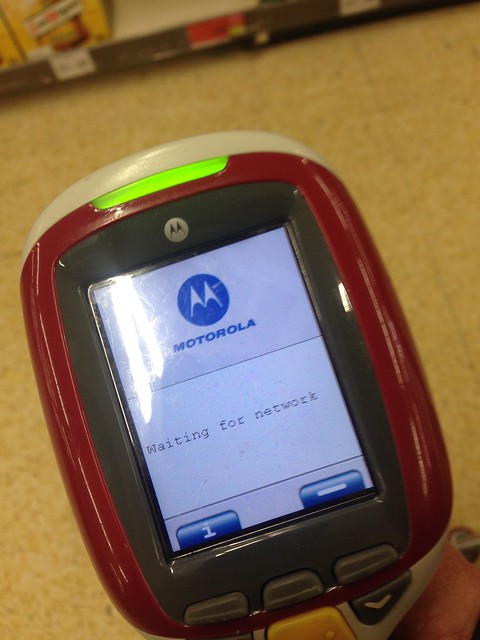
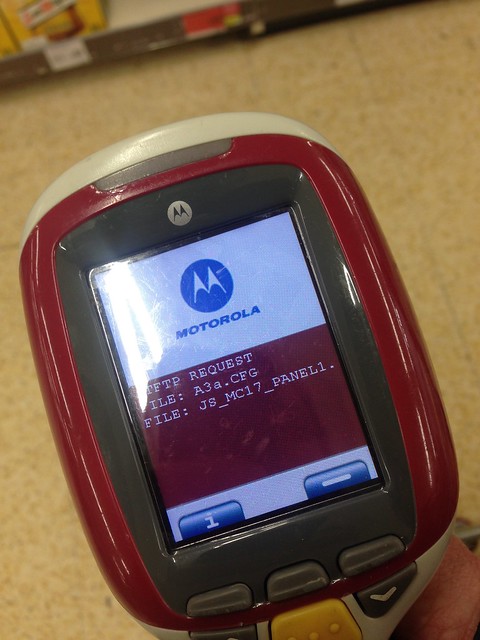
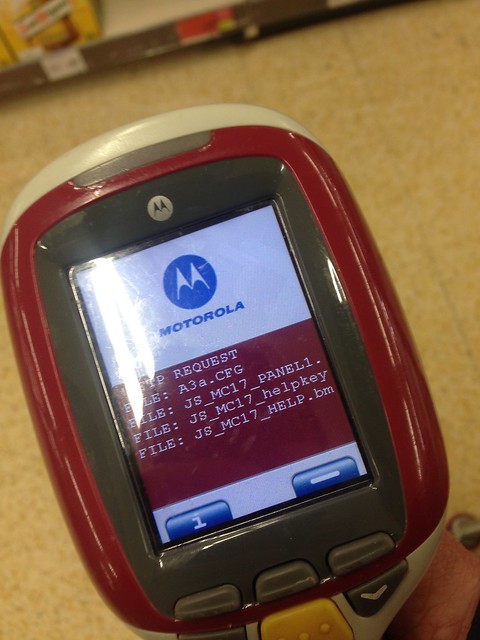
There were a few more screens but it as interesting to see the boot sequence.
Then all the data I had scanned appeared. It was probably only a minute or so, but I was very impressed that the system had a continuous backup, or maybe it is a local cache, of the details. I had to rescan my last two items, as they were the ones it had hung and crashed on, but it worked fine.
Retail is great at mining data and working out who buys what, I assume that they use richer data from the scanners to determine when something is bought. With this constant network connection there is scope for the next generation of these hand held units to deliver more than just the occasional information message.
I can imagine some less tech savvy consumers might be a bit freaked out by the apparently simple little listing device doing all this, and rebooting, which is why it is handy to have some background knowledge of the technology. It made it an interesting little sojourn and break from the current workload. It also showed we are already in an age of IoT, this constantly connected device sorted its own problems out and came back working. Lets hope all the new devices connecting can do the same thing.
Why an IoT book?
The Internet of Things (IoT) is an increasingly popular tag to place on almost everything out in the industry at the moment. It has far surpassed any discussion of Web 2.0 or Internet 3.0. In part it works because it does not have a version number. We all know about ‘The Internet’ as a support structure for the World now. The increase in mobile and app usage has helped separate it from ‘The Web” for many people. We used to, in briefings, have to explain the Internet as the connection of all the devices and the web was an information layer on top. The Web is not the the Internet. I think the average person in the street, bar, front room, office etc would probably think of the Internet as getting a Wi-Fi signal or a 3G/4G set of bars on their smartphone.
It is this social awareness, of connectivity, that lets the term IoT resonate with people. We all have devices that are connected to our WiFi or have some sort of sim card in them, that do not need us to be present for them to operate and communicate. Xbox and PS4 patch themselves over the air, dropbox and iCloud etc. synch their fields all over the place so we always have what we need. These are all simple everyday items already connected to the net and doing their thing. So they are obviously part of the Internet of Things, in common parlance.
That common understanding of connectivity and remote action runs into everyday life and therefore into the everyday life of people in business, CEOs, CIOs and alike combined with new product development and consultants helping shape all of industry.
So, yes, it’s another buzzword to hang everything on, but also, yes it’s really very important to us all. In a recent talk to Predlet 1.0’s year 8 secondary school class I explained to them how important IoT as an idea was to their future. Mainly this is because, aside from a technical career path building things, knowing and appreciated the connectedness of things may generate new industries and businesses that they will work in, or hopefully create.
This pitch was on top of the ‘normal’ discussions of virtual worlds, augmented reality, game technology, 3D printing, brain control devices, and open source attitudes. All those are my bread an butter, but they are also part of the general IoT umbrella of concepts and ideas.
One branch of IoT is that of sensors, instrumenting the World to gain a better insight into what is happening. We have had networked sensors for a while, but they are getting cheaper and more detailed in what they can deal with. This branch smashes into virtual worlds, at least it does where I started with it more publicly in 2006. The World of tennis was being instrumented by Hawkeye. The physical position of the ball was/is captured, via cameras and converted to x,y,z positional data. I used that data to re-visualize the ball tracking in Second Life, in a virtual world. That encompassed a visual representation of an Internet of Things style sensor reading of the physical World. That of course is a one way interaction, but allows many people to immerse themselves in the data at the same time online in a shared space. Tracking those people to help understand what they were watching and doing generated a heat map of activity. That is because it is easy in a virtual world to instrument everything. Avatars and objects re being rendered in a space that has to know where they are in x,y,z space, hence it can be collected and reported on. Making virtual worlds and ideal place to try out large scale instrumentation. What if… there were sensors on this, and there were 1,000 of them dotted around a town, how about 10,000? Oh look something is moving, follow it etc.
Whilst on virtual worlds, one of the first projects that arrived on Hursley island in 2006 in Second Life, was an angle poise lamp. To many people it seemed just like a fancy model, but the guys had wired in the distal lamp to the external World. The lamp was connected by the now open source MQTT protcol. A real lamp in the real lab could be turned on and off with an MQTT message that the lamp was subscribed to. The digital version subscribed to the same message so was in synch with the real world. The virtual bulb lit up when the message was sent. This was also built 2-way though, if you hit the virtual switch it also sent the message, just as the previous web page had. We used it as an example of integration and of pub/sub messaging but also to help people understand the environments are not stand alone, or they don’t have to be.
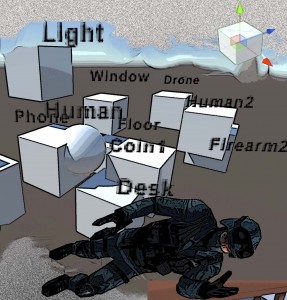
Roisin’s view of the World mocked up during storyboarding the novel.
This detail, about instrumentation and altering the World or knowing what is going on is why I had to label my Sci-fi novel Reconfigure, and the follow up Cont3xt as IoT books in Amazon. Currently if you search for “IoT Books” Reconfigure appears in the top ten of books on the subject. I am not jumping on a bandwagon as such, in the book the World is instrumented and Roisin controls and understands it with an virtual/augment interface. Whilst part of the extension into Sci-fi is made up, the grounding is in a long history of having been ardour this stuff and the experience that brings.
BTW don’t forget, a kindle book does not need a kindle to read it. Amazon has a set of apps and readers for most platforms. So if you want to see IoT in the future, check it out.
Reality Editor – Seeing IoT
This video is doing the rounds, Wired also reported on it. It is the latest instalment in a project from MIT. It uses augmented reality to show you the connections between your connected devices so that you can do things to those connections in the physical World. It is called the reality editor. I has been an ongoing project, see the second video for the one from a couple of years ago.
UPDATE Jan 2016 – They seem to have removed this new video from Youtube. I am currently looking for the right version.
This is very interesting on a number of fronts. Firstly the use of augmented reality to do something that you interact with, not just see adverts etc.
Secondly, it is applicable to the next generation blended reality headsets like magic leap and hololens.
Thirdly, it’s another piece of real technology that makes my sci-fi novel even more grounded in reality. The sort of interface that is used here is the sort that Roisin uses in Reconfigure, except she can move real things in space and combine materials, not just wiring and plumbing as the current technology shows.
It seems strange to write ‘just’ when referring to something so leading edge. It is that odd balance between the joy of some cool technology getting into peoples hands and everyone getting the point rather than nay saying, versus the ‘enjoy this I made it up.’ approach that I am currently taking with the science fiction.
It all is towards the same technology evangelist goal of helping people come to terms with all this change and to embrace and expand upon it.
Here is the original video from 2013 of the fluid interface concept of the Reality Editor.
Just think what you could do with this, and how far you could take it.
Soon(ish) Reconfigure will be a historical document 🙂 I am glad I put some suspense and drama in it too no just tech 🙂
Free book promo – Reconfigure
This weekend, from now until Monday Reconfigure ebook is FREE to download from Amazon.
http://www.amazon.co.uk/gp/product/B01720X7F0 in the UK
http://www.amazon.com/dp/B01720X7F0 in US
But is is also available in almost every Amazon store and region.
Having had this rip roaring sci-fi techie adventure on published at £1.99/$2.99 for the past month I thought I should join in with the Black Friday/Cyber Monday fun now I have an actual product, and one worth people seeing, reading and enjoying.
I have tried lots of other routes to promote the book, which is interesting from a standing start and only having the idea to write it in September. This is one more tool in the box to try.
It would dare great if everyone who follows me, who I have every presented to, worked with, trained with, amused or helped would download it this weekend. I hope a few people would then choose to add to eh reviews on Amazon and some nice stars too.
If you have not seen the promo video this explains the book a little to (no spoilers)
The next book con3xt is coming along nicely, taking the story even further.
Thankyou for all the support so far, and thankyou for taking advantage of this offer to help me out.
UPDATE 30/11/2015
Whilst there is still a few hours of the promo left I was very pleased to see the UK stats come through.
So the result of this part of the process was a very pleasing one.
A UK Number 1 download in its genre and Number 14 in UK general science fiction.
It has reached the US top 100, as high as 52 in general science fiction, and also number 2 in its sci-fi genre on Amazon.
This is still time for the the numbers to go up of course, but I am taking stock and celebrating this success. It only happened because so many people were willing to go and download it. I think most people will enjoy it. Either way the No. 1 is a shared achievement. Thank you all.
Two STEMnet events this week
It has been quite a busy week of STEMnet activity. Being a STEMnet ambassador means helping schools and students however I can. Tuesday I spoke to a local secondary school teacher about all things emerging tech that might inspire the next generation. It was pretty much like rebooting Cool Stuff Collective. It is good to share my passion for new tech and some of the unusual twists and turns that I get to explore. This is all voluntary but it is still a service that I try and provide.
Today was a different event I joined about 20 other STEMnet ambassadors from all sorts of parts of industry, currently working and retired. We were at the Winchester Science Centre (I still call it Intech). It was where were shot one of the road trip episodes on Cool Stuff Collective. It was an event aimed at secondary school boys specifically. It was delivered as part of International Mens Day. This may seem strange to focus on us males in the workplace given there already lots of men in the industry. However, it is not always a good idea to ignore one part of society. These boys also needed the information and role models to talk to. So the excuse of a international day or event regardless of gender makes sense to catch some of them.
The day would work as well for groups of girls, the events and experiences were not specifically blokey.
We had groups building bristlebots and trying to make them go in a straight line. (These are DIY versions of Hexbugs. A bristle, like a toothbrush has a vibrating solenoid strapped to it. It causes the bug to shake itself forward in a very insect like way.
One of the very enterprising teams decided to forego the placing of pipe cleaners and weights etc to make the bug drive straight. Instead they build a rail system with straws as outriggers bolted to the bug bug much wider than it. It was a bit of a cheat, but as there were no rules I think it was a very cool build for the 15 mins they had.
The other even was trying to build a small ramps out of kinex and paper only for a micro RC car to jump off. The cars were very twitchy and it was q tricky task to even hit a ramp let alone build one. This made it even more entertaining to watch.
The final hands on was a robot arm test of teamwork. In cross school groups two people at a time had to control the arm and try to pick up the blocks. Every 30 seconds they were swapped out for other people in the team.
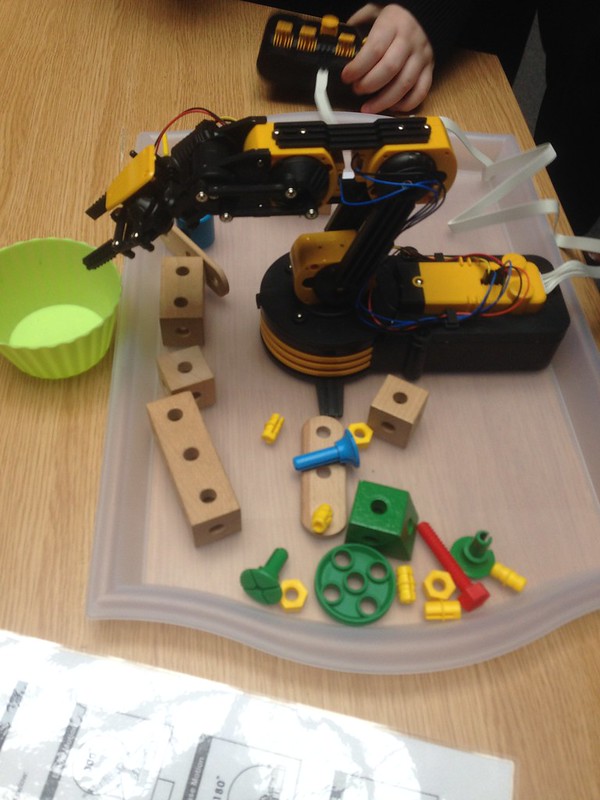
The final part was a speed networking. Each of us STEMnet ambassadors had table and every 4 minutes we talked to 5 students about our life and our work. We all had props. I had the MergeVR headset, my 3d printed Makie, my Flush magazine articles and of course a copy of Reconfigure I told them all about IBM and about virtual worlds and VR and the journey via TV presenting and now authoring. Still that I am a programmer, but that there is a lot they can chose to do.
One question I got was about whether it paid well. I explained a corporate job pays very well, but when you leave that money is a different matter altogether. Trying to sell a book to generate a bit of income, or chasing contracts of any value is tricky when you do leading edge stuff. I did explain that they should focus on IoT as a way forward. That would be a lucrative set of things to invent and get into.
After lunch we were treated to a full planetarium fly through. It was a bit like playing Elite Dangerous but we went out even further. The narrator/pilot was fantastic.
It was a very rewarding day indeed I think. It was also great to meet to many other people interested in helping others grow their STEM knowledge.
Human endeavour – it is what counts
On Saturday we took a family trip to London to the Lee Valley Velodrome on the 2012 Olympic park site. We had tickets to see the Revolution series. Here various pro cycling teams and riders from around the world compete indoors on the banked circuit. WE had been to see some of the Olympics during 2012 but that was the gymnastics at the O2/Millennium Dome so we had not seen the big stadium, giant sculpture nor the velodrome yet.
As predlet 1.0 is currently on crutches, with a heavily sprained ankle, we chose to go overland from Waterloo station to the park in North East London. The cabbie set off North, but our visit clashes with the road closures for the Lord Mayor’s show. So after a u-turn we skirted around the city and then he headed up towards the Velodrome. It was a drizzly rainy day but we did get to see a lot of London.
The Velodrome itself is a fantastic looking building from the outside.
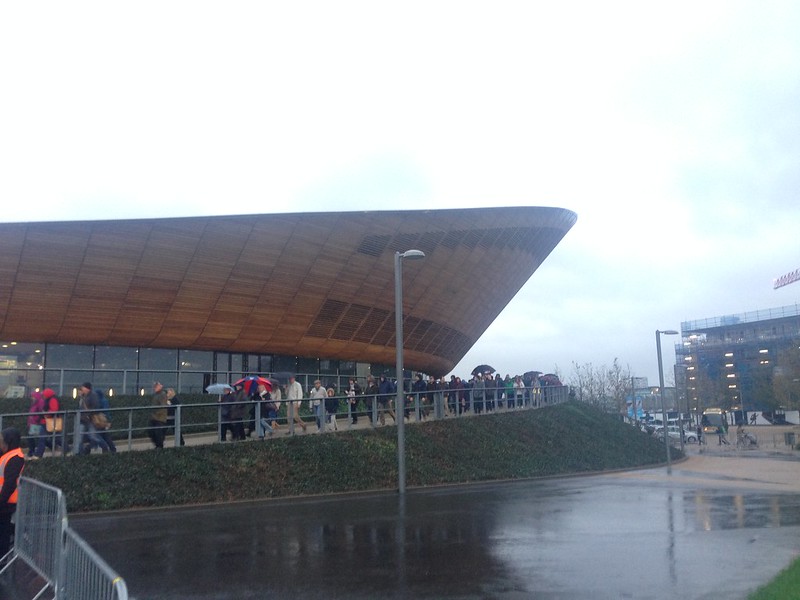
It is a huge bowed wood clad curve. The entire building is raised up on a plinth and the glass walls around appear to support the wooden structure. You are let in through an air lock in small groups. The idea is to keep the air and temperature stable inside to protect the track.
Inside it makes sense that the entire structure is raised up as the banked track is incredibly deep and steep.

There are two tiers of seating, but everyone can see everything. The riders and track were very close to our seats, and we got a good view down a straight.
The preparation area, for warm up and warm down is located in the infield. So there is always something going on, some form of activity.
We got to see several types of races and mass warmups around the track in between too. The first was with individual riders. It was just them against the track and the clock. Whilst not being bike racing affiecienados it was amazing how quickly we all saw the minute differences in technique and speed that led to different times. You just knew when the winning time was being made. You could feel the wonderful interlocking of all the training with the effort on the day coming into play. The first 200m race (which the clock started a little after the start finish line) was separated by milliseconds. The top time were around 10 seconds to cover the 200m, after 2 laps to wind up to the sprint.
The predlets had not really come across fixed wheel bikes but they soon got the gist of how they worked and the fact these athletes were traveling at over 40 miles and hour with no brakes.
The sprint races were great, it was very crowd friendly and we were able to cheer and support everyone, but particularly the locals. Everyone was cheered though. It is incredibly obvious the effort that they have to put in to be able to move at those speeds. The banked curves and the pressure to try and control the bike, choosing the right line etc it less obvious but was intriguing to watch.
The one on one races were interesting too. These are the ones where the try and catch one another out. They have three laps to complete, but the first one or two are done at a very slow pace, keeping an eye out for the break. The acceleration and power as they wind up the bikes means a fraction of a seconds jump on someone matters. Equally, go to early and you loose power or the other person gets a slip stream. Again these were easy to follow.
The most impressive races were the mass races of 20 or so riders. The Women’s race was 80 laps and the Men’s 120. They tended to stay in a streamlined group unless one chose to break away. Every 10 laps was a sprint lap with points awarded for the top people crossing first. Extra points were on offer for lapping the field. Here is got a bit confusing, the comentator did their best but we got a bit lost as to the rules. When and where the lapping occurred and if it got reset after the sprint lap. It was very impressive though. a constant almost silent whoosh of power sooting past every 10-12 seconds.

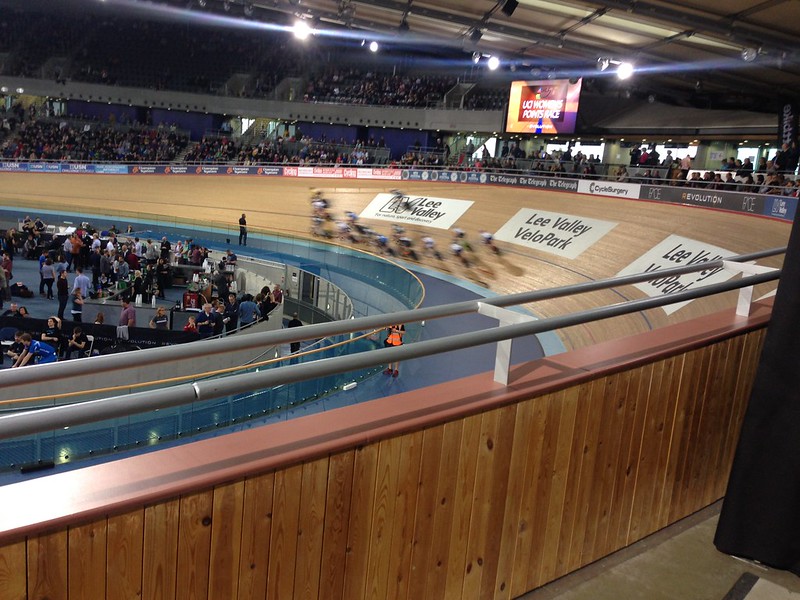
Another race format was the elimination. Each lap the one at the back dropped off until there were 10 then they raced.
The final race was the strangest. A large proportion of it involved not racing at all. It was called the Longest Lap. Here all the riders attempted to balance near the star finish line, on the banked straight. They had to stay upright, no crossing the line for 3-4 minutes. A foot down or holding on and they were out. Then the signal would go and they all raced form a standing start for 1 lap. About 1/3 dropped out before the race.
It was interesting, but seemed a little odd. Then I remembered we used to do this as kids. How long can you balance on your bike without moving. So it is not quite so odd. As a spectator sport watching people balance was actually good too.
We had a great time at the Velodrome. I have to say the tea at the canteen was great too. Lots of venues have food places that are pretty bad or just non-descript. The fresh crepes, cakes and tea at Lee Valley are very nice though.
I entitled this post human endeavour – it is what counts. The combined experience of the science and technology and engineering that created the building, with the effort that the athletes and their teams put in and the variety of experiences over and above just cycling fast combined with a willing and happy crowd of spectators was and is very uplifting.
Everything is about building and improving. That includes hard work and effort, that making it worthy of celebration.
The previous weekend we had our annual trip to see Jools Holland and his Rhythm and Blue Orchestra. It was another amazing show, as usual. In fact it was probably one of the best yet. It is another example where the hard work and effort of the musicians to learn their craft is celebrated by them sharing it with us. The dexterity of Jools Holland on the piano is stunning, the drum solo by Golson Lavis is always a fantastic highlight. Not only one of the greatest drummers ever, but he is there all the time for the whole 2 hour show. These solos everyone else leaves and lets him get in with it. Here is an example. It is well worth the listing to the whole thing and feeling the effort and the effortlessness combine with all his years of experience.
Everyone should have the opportunity to find their talent and to work at to, building on all that came before. It is human endeavour that counts.

